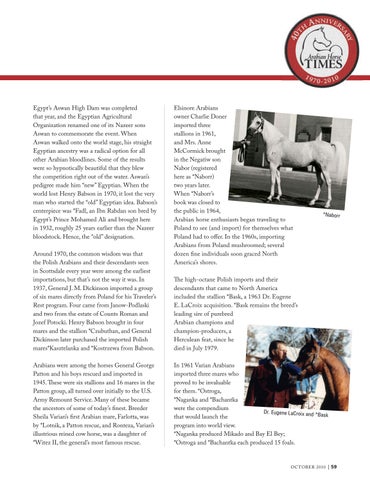Egypt’s Aswan High Dam was completed that year, and the Egyptian Agricultural Organization renamed one of its Nazeer sons Aswan to commemorate the event. When Aswan walked onto the world stage, his straight Egyptian ancestry was a radical option for all other Arabian bloodlines. Some of the results were so hypnotically beautiful that they blew the competition right out of the water. Aswan’s pedigree made him “new” Egyptian. When the world lost Henry Babson in 1970, it lost the very man who started the “old” Egyptian idea. Babson’s centerpiece was *Fadl, an Ibn Rabdan son bred by Egypt’s Prince Mohamed Ali and brought here in 1932, roughly 25 years earlier than the Nazeer bloodstock. Hence, the “old” designation. Around 1970, the common wisdom was that the Polish Arabians and their descendants seen in Scottsdale every year were among the earliest importations, but that’s not the way it was. In 1937, General J. M. Dickinson imported a group of six mares directly from Poland for his Traveler’s Rest program. Four came from Janow-Podlaski and two from the estate of Counts Roman and Jozef Potocki. Henry Babson brought in four mares and the stallion *Czubuthan, and General Dickinson later purchased the imported Polish mares*Kasztelanka and *Kostrzewa from Babson. Arabians were among the horses General George Patton and his boys rescued and imported in 1945. These were six stallions and 16 mares in the Patton group, all turned over initially to the U.S. Army Remount Service. Many of these became the ancestors of some of today’s finest. Breeder Sheila Varian’s first Arabian mare, Farlotta, was by *Lotnik, a Patton rescue, and Ronteza, Varian’s illustrious reined cow horse, was a daughter of *Witez II, the general’s most famous rescue.
Elsinore Arabians owner Charlie Doner imported three stallions in 1961, and Mrs. Anne McCormick brought in the Negatiw son Nabor (registered here as *Naborr) two years later. When *Naborr’s book was closed to the public in 1964, Arabian horse enthusiasts began traveling to Poland to see (and import) for themselves what Poland had to offer. In the 1960s, importing Arabians from Poland mushroomed; several dozen fine individuals soon graced North America’s shores.
*Naborr
The high-octane Polish imports and their descendants that came to North America included the stallion *Bask, a 1963 Dr. Eugene E. LaCroix acquisition. *Bask remains the breed’s leading sire of purebred Arabian champions and champion-producers, a Herculean feat, since he died in July 1979. In 1961 Varian Arabians imported three mares who proved to be invaluable for them. *Ostroga, *Naganka and *Bachantka were the compendium Dr. Eugene LaCroix and *B ask that would launch the program into world view. *Naganka produced Mikado and Bay El Bey; *Ostroga and *Bachantka each produced 15 foals.
OCTOBER 2010 | 59
